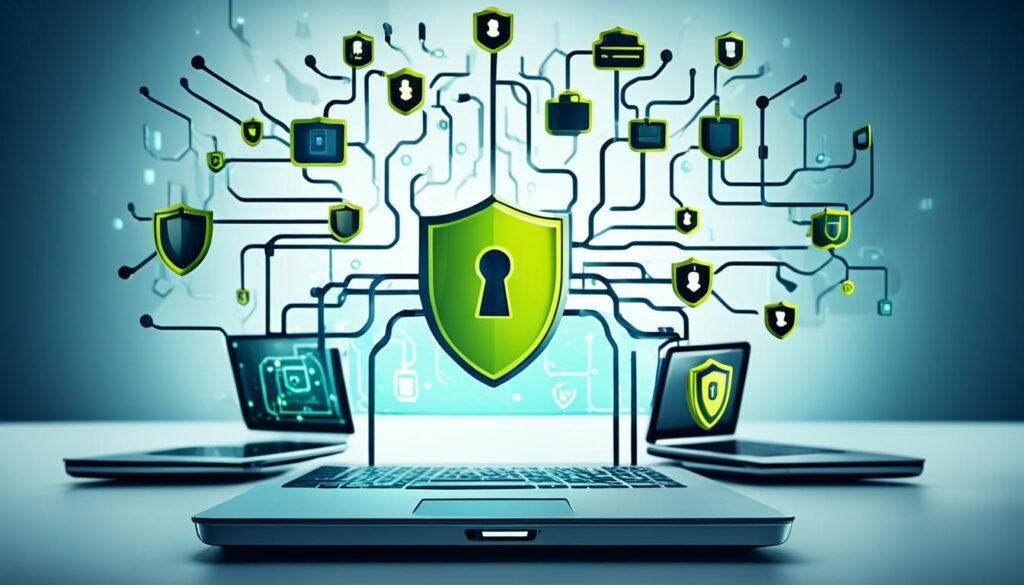IoT Security: Protecting Connected Devices in Irish Homes and Businesses
IoT spending hit a trillion dollars in 2022 globally. This shows how much IoT devices have grown. But, it also means we need strong security for our homes and companies in Ireland.
The Mirai botnet attack in 2016 is a big cautionary tale. Over 145,000 IoT gadgets were used to crash servers. This shows how at risk our devices are.
Keeping our gadgets safe is crucial as they become more integrated. Companies like Microminder have been leading in IoT security for over forty years. They protect our devices, keeping our info safe.
Key Takeaways
- Global IoT spending hit the trillion-dollar mark in 2022.
- The Mirai botnet attack highlighted significant vulnerabilities in IoT devices.
- Strong IoT security is essential for protecting data and ensuring device integrity.
- Microminder has been a reliable partner in cybersecurity for over 40 years.
- The rise in IoT devices necessitates advanced security measures for Irish homes and businesses.
The Importance of IoT Security in Modern Times
The use of IoT devices in homes and businesses is growing fast, raising the need for Cybersecurity Importance like never before. With the world spending lots of money on IoT, it’s vital to keep these devices safe. By 2020, the average U.S. home had about 10 interconnected devices. This means homes and companies now face the challenge of securing many different devices.
Switching from reacting to attacks to preventing them is now more important than ever. The 2016 Mirai attack showed how powerful and simple IoT devices were used to bring down big parts of the internet. One big problem is devices using weak or default passwords, which lets hackers in easily. To keep Online Safety, it’s crucial to assign someone to manage IoT devices and to always update them with the latest security patches.
The Covid-19 pandemic made us work from home more, relying heavily on our home networks and IoT devices. This change made us see even more how critical Cybersecurity Importance is. The issue is that IoT devices don’t always have strong built-in security, making them easy targets for cyber attacks.
The move to 5G is expected to vastly improve how we secure IoT devices. There’s a lot of effort going into making IoT connections safe for companies, which is a good sign for the future of Smart Device Trends. It’s essential for users to focus on securing their Wi-Fi, watch for odd network activity, divide their network into segments, and protect their IoT connections with the cloud to keep them safe.
People are very worried about IoT security, with 90% feeling unsure about their device’s safety. Managed Security Service Providers (MSSPs) are stepping in to offer help in keeping networks and individual devices secure, thus protecting businesses and data. Making every internet-connected device safe is crucial. It keeps us safe from potential dangers, even when our network seems secure.
Common IoT Device Vulnerabilities
In the IoT world, knowing the common vulnerabilities of devices is key. It’s vital for better securing networks. These flaws can put personal or business data at risk if not fixed quickly.
Weak Passwords
Attackers often break into IoT devices using weak passwords. This happens a lot, like with the Mirai variant, Mukashi. It used simple, default passwords to get into Zyxel NAS devices. Users should change these simple passwords right away. Also, they should use stronger, more complicated passwords.
Unpatched Firmware
Keeping devices updated with the newest firmware is important. Without updates, devices could install harmful, unauthorized software. This leaves organizations open to more cyber attacks. Cybercriminals find it easier to attack a device that’s not up-to-date.
Insecure Network Connections
If networks are not safe, cybercriminals find it easier to break in. In 2017, Trend Micro found flaws in Sonos smart speakers’ network security. They had open ports. To stay safe, strong Network Security is a must. This includes using encryption, VPNs, and firewalls.
Default Settings
Many IoT devices come with easy-to-use, but very insecure, default settings. These can make it simple for attackers to get in. The 2016 Mirai botnet attack proved this. It used many unsecured IoT devices to do a DDoS attack.
| Vulnerability | Description | Example |
|---|---|---|
| Weak Passwords | Easy to guess or default passwords | Mirai variant Mukashi exploiting Zyxel NAS |
| Unpatched Firmware | Outdated software making devices vulnerable | Lack of regular firmware patching |
| Insecure Network Connections | Unsecured network protocols and services | Sonos smart speakers with open ports |
| Default Settings | Insecure initial device configurations | Mirai botnet using default setup |
Dealing with these vulnerabilities needs active management. This includes changing default settings, updating firmware regularly, and boosting network security. These steps are crucial for making the IoT world safer for everyone.
Cybersecurity Challenges for Irish Homes and Businesses
Irish homes and businesses are dealing with more security challenges due to IoT devices. By 2020, over 25% of hacks will involve IoT, warns Gartner. This makes Irish cybersecurity a big issue.
The Stuxnet malware and the Mirai botnet attacks were big problems. They showed the need for better cyber resilience in dealing with cyber threats. These events point out the risk to Irish companies’ IoT setups.
Irish cybersecurity also involves fixing easy-to-guess or preset passwords in IoT gadgets. The Mirai malware took over 400,000 devices by using this weakness. It shows how quick and easy cybercriminals can break in.
Companies that make these devices have a big role too. They should fix any security flaws quickly and set up safe ways to update their tech. Malware like Reaper, aimed at devices to carry out cyber attacks, stresses the importance of these updates.
Cyber-attacks can have a huge impact. Just before a casino hack, guests had already spent nearly $53.7 million. This shows how security breaches can lead to serious losses in profits. Also, the Department of Homeland Security gave severe security ratings to Medtronic’s devices, underlining the importance of strong security.
To create cyber resilience in Ireland, everyone needs to work together. Users should change passwords, turn on secure options, and update firmware. Companies should use encryption and other methods to protect their tech and networks.
Tackling the changing threats needs a thorough plan for threat prevention and cybersecurity. Understanding and combating IoT issues can help keep Irish homes and businesses safe.
Best Practices for Smart Home Security
Using Smart Home Best Practices is key to safeguarding your smart gadgets. Threats like the Mirai botnet and VPNFilter malware put your home at risk. By following strategic steps, you can keep your smart home safe.
- Use Strong Encryption: Strong encryption, like WPA2, keeps Wi-Fi safe from intruders.
- Secure Network Protocols: Secure Network Protocols guard your network against cyber attacks. For instance, keep an eye on your connected devices to locate possible risks.
- Regular Software Updates: Always update your smart devices to fix security issues. Turn on automatic updates to get these fixes quickly.
- Digital Safeguards: Boost your security with two-factor authentication on all your smart-device accounts.
- Complex Passwords: Make sure your passwords are strong by using a mix of letters, numbers, and symbols. This is vital for both your Wi-Fi and your device accounts.
- Disable Unnecessary Features: Stop using features you don’t need, like UPnP, to lower the risks on your devices.
- Guest Networks: It’s a good idea to have a separate network for visitors that keeps your IoT devices safe from their devices.
Routers and cameras are often targets due to weak security. Using default or easily guessed passwords makes IoT devices easy prey. This is why IoT Protection suggests steps like changing these passwords first thing.
Both Norton 360 and Trend Micro™ have tools to help protect against viruses and cyber threats. McAfee stresses the need to secure even unusual smart devices like smart coffee makers.
| Practice | Benefit | Examples |
|---|---|---|
| Strong Encryption | Secures Wi-Fi networks | WPA2 |
| Secure Network Protocols | Prevents unauthorized access | Mapping and Monitoring |
| Regular Updates | Patches security flaws | Automatic Updates |
| Complex Passwords | Enhances login security | Alphanumeric and symbols |
| Guest Networks | Segregates IoT devices | Separate Network |
By strictly sticking to these Smart Home Best Practices, you can make your home’s digital defenses very strong. Doing regular checks and staying on top of new security methods is also crucial for a safe smart home.
IoT Security: Protecting Connected Devices in Irish Homes and Businesses
Our world is now more connected than ever. This has led to a huge increase in data from IoT devices. This data includes our location, what we buy, and even the air quality around us. To keep this data safe, we need strong IoT Cybersecurity Solutions. These solutions fight off dangers like easy-to-guess passwords and outdated software.
The more IoT devices we use, the more we open ourselves up to attacks. This is why IoT Defense is so critical today. Companies making these devices should put security first right from the start. They should make sure the devices can only connect safely, by ensuring networks are secure and keeping a close eye on who’s allowed in.
Encryption is vital in keeping our data safe as it moves between devices and online. With more and more data living in the cloud or on just hardware, top-notch Connected Device Management is a must. These systems are there to check that devices are following security rules.
Using strong security practices like double-checking who’s trying to connect and keeping all software up to date is key in keeping IoT systems safe. This is where companies offering services like Microminder step in. They provide top-level cybersecurity to protect homes and businesses in Ireland from the latest threats.
- In the U.S., the average household has about 20.2 connected devices, whereas European households have 17.4, and Japanese households average 10.3.
- The rise in connected devices has seen increases in smart home gadgets: a 55% surge in smart cameras and a 43% rise in smart doorbells worldwide from 2021 to 2022.
Actively working on IoT cybersecurity means we can make sure Irish homes and businesses stay safe from cyber attacks. By putting strong measures in place and diligently protecting our devices, we can enjoy the benefits of IoT. And we can do this without worrying about our safety online.
The Role of Encryption and Authentication in IoT Security
Securing IoT devices is crucial. There will be over 25 billion devices by 2030. This is a 300% increase from 2020’s 8.7 billion. This growth makes security measures like Encryption Standards and Authentication Solutions vital. They keep data and communications safe from harm.
Types of Encryption
Encryption protects the data IoT devices send and receive. It keeps sensitive information private and secure. There are different types of encryption:
- Symmetric Encryption: Uses one key for both scrambling and unscrambling data. It’s quick but needs careful key handling to stay safe.
- Asymmetric Encryption: Uses a pair of keys, public and private, for better security. However, this method is slower than symmetric encryption.
- End-to-End Encryption: Keeps data safe from its sender to receiver. No one else can read or tamper with it in the middle.
Authentication Methods
Strong Authentication is key to letting only the right people and devices into IoT networks. There are different ways to do this:
- Password-based Authentication: It’s simple but needs strong, unique passwords. This helps stop unauthorized entry.
- Two-Factor Authentication (2FA): This adds a second verification layer. It greatly boosts security by needing more than just a password.
- Biometric Authentication: It uses your unique features, like fingerprints. This offers very high security.
Importance of Encrypted Communications
Using encryption for IoT data is critical. Without it, your information is open to cyber attacks. By properly encrypting all network data, you prevent others from reading it. This maintains data’s safety and avoids harmful breaches. Strong encryption and authentication tools reduce the chances of attacks on vulnerable devices.
| Security Measure | Benefit | Examples |
|---|---|---|
| Encryption | Protects data integrity and confidentiality | Symmetric, Asymmetric, End-to-End |
| Authentication | Ensures only authorized access | Passwords, 2FA, Biometrics |
| Encrypted Communications | Prevents data interception | Encrypted IoT Communications |
Updating Firmware and Software for Enhanced Security
Keeping IoT devices secure is very important today. Threats from the internet keep changing. A key step to making IoT devices safer is to update their software and firmware regularly and systematically.
Scheduling Regular Updates
It’s critical to update devices with new security patches promptly. In 2016, the Mirai botnet attack showed how bad things can get if updates are not done. A regular schedule for updates can stop such major problems by fixing weaknesses early.
Automatic vs. Manual Updates
Choosing between automatic or manual firmware updates has its challenges. Automatic updates are easy and keep devices current. Manual updates let you check update details first. But waiting too long for manual updates can open your devices to attacks, like what happened with the Russian group Strontium in 2019.
Risks of Outdated Firmware
Not updating firmware brings big security risks. Hackers often target devices with outdated firmware. To make IoT devices more secure, regular updates are a must. Without these updates, private data could be at risk. It also opens the door for unauthorized access and major cyberattacks.
| Update Type | Pros | Cons |
|---|---|---|
| Automatic |
|
|
| Manual |
|
|
Wireless Network Protection Strategies
Keeping your wireless network safe is key for IoT device security. Sadly, about 76% of IoT users do not take security seriously. They don’t secure their devices well, which makes them easy targets for cyber threats. The most important part of keeping your network safe is setting up strong Wireless Security Measures. Even simple steps, like using unique usernames and passwords, can help a lot. But many people, more than 80%, forget to do this.
Breaking your network into smaller parts can help keep IoT devices safe. This way, if there’s an attack, it might not spread everywhere. Using a Remote Management and Monitoring (RMM) tool can make updating IoT devices easier. This improves how quickly we can fix problems.
By adding encryption like AES or DES, the data your IoT devices send is safer. Using Simple Network Management Protocol (SNMP) tools lets you watch over your devices from one place. This makes it easier to see what’s happening on your network. With IoT growing fast, we must use these security tips to keep up and stay safe.
| Security Measure | Benefit |
|---|---|
| Changing Default Passwords | Reduces susceptibility to attacks |
| Network Segmentation | Limits access to critical systems |
| RMM Solutions | Streamlines patching processes |
| Encryption (AES/DES) | Secures data transmission |
| SNMP Solutions | Centralized monitoring |
Both at home and at companies, making sure IoT devices connect safely is critical. With over 29 billion IoT devices expected by 2030, strong Network Protection Strategies are more important than ever.
Remote Access Control and Management
Keeping IoT devices secure is vital through strong *remote access control and management*. Using secure Remote Access Security and Connection Monitoring helps reduce risks and stops unwelcome entries. This protection is increased by adding tough IoT Management Protocols. These make sure only trusted users can reach important systems.

Securing Remote Access
Making sure remote access to IoT devices is safe is key. It’s done by using strong ways to confirm, like multifactor steps and safe talks. This keeps the system safe from those not allowed, protecting it from attacks.
Access Control Protocols
It is crucial to have *access control protocols* that are strict for IoT devices. These protocols help set careful rules for who can touch what. By highlighting IoT Management Protocols, the safety and privacy of data travelling between places stay high.
Monitoring Remote Connections
Watching connections closely is a big part of keeping IoT setups safe. Always keeping an eye out catches odd stuff quickly and blocks off dangers. With the right *logging and monitoring tools*, dangers can be found fast. This keeps the security of linked devices strong.
Protecting Data Privacy in IoT Ecosystems
Keeping data private in IoT systems is now super important because of new laws. The world of IoT and data privacy is tricky. This is because many IoT gadgets don’t process data well, like old PCs. So, it’s key to carefully protect info, using strong security from different tech makers.
One big step is the UK’s rule for IoT security. It bans easy-to-guess passwords and makes tech companies tell about any flaws. These rules help keep our info safe and stop hackers from getting it.
The cost of making IoT devices safe is also a big deal. Making security skip-proof, while keeping costs low, can be hard, especially with lots of devices in use. To tackle this, companies are making tools that set up and update devices more easily. This way, they’re safer from the start.
Companies must show they’re trustworthy when they make and ship IoT stuff. If they don’t, people can lose trust, which is bad for business. New ways of setting up devices are crucial. These make sure they can easily stay secure, lowering the chance of privacy problems.
- SecureIoT found and checked issues in smart robots in a flash.
- SEMIoTICS tested its plan in health care, green power, and smart sensing for data safety.
- ENACT made sure IoT works well in train safety for travel safety.
- IoTCrawler was great at spotting odd water use to save resources, sometimes seeing it before it’s a big issue.
The EU also made a big effort to improve IoT safety by funding eight key projects. Each gets about €5 million, showing how much they care about keeping our info private online.
At the same time, making sure new features get to our gadgets, and that online platforms are secure, is a huge challenge for companies. They sometimes have to think about having others help with the software. This shows us just how challenging and crucial it is to keep our data private within IoT systems.
Conclusion
The world of connected devices is growing fast. By 2027, we expect around 30 billion devices to be online. Now, about 40% of homes worldwide use these gadgets. This number is even higher in North America, reaching about 70%. This shows how much we rely on these technologies.
To protect our devices, we need advanced security. Aman et al. show how to set up strong safety plans. Meanwhile, Zolotukhin et al. suggest using AI for defense. New tech like SDN and NFV, along with machine learning, helps spot threats in real time. This, along with fog computing and blockchain, makes our devices safer.
The future needs more focus on cybersecurity. All sectors, from services to energy, have to keep up with new threats. They are doing this by using better VPNs, like Raspberry Pi ones. Also, they use advanced VPNs with IPSec for many types of access. Monitoring the network traffic closely is critical, especially against mobile network attacks. These steps make us stronger against cyber threats.
Source Links
- Microminder IoT Security Solutions | Microminder Cyber Security | Microminder Cybersecurity | Holistic Cybersecurity Services
- IoT Security: Risks, Examples, and Solutions | IoT Glossary
- What is IoT Security? Definition and Challenges of IoT Security
- IoT Security Issues, Threats, and Defenses
- Are Your Mobile and IoT Devices Weakening Your Security?
- Building trust in IoT devices with powerful IoT security solutions
- Top IoT Device Vulnerabilities: How To Secure IoT Devices | Fortinet
- Smart Yet Flawed: IoT Device Vulnerabilities Explained – Nouvelles de sécurité
- The Security Minefield Of The Internet Of Things: Protecting Your Connected Devices
- IoT Cyber Security: Trends, Challenges and Solutions
- Top IoT Device Vulnerabilities: How To Secure IoT Devices | Fortinet
- IoT security issues in 2022: A business perspective
- 12 tips to help secure your smart home and IoT devices
- The First Steps in Effective IoT Device Security – Nouvelles de sécurité
- How to Secure Your Smart Home: A Step-by-Step Guide | McAfee
- IoT Security Best Practices? How To Protect IoT Devices | Fortinet
- Make Your Smart Home a Secure Home Too: Securing Your IoT Smart Home Devices | McAfee Blog
- Securing the Connected Home From Outside Threats > Thread Group
- Cybersecurity in the Age of IoT: Challenges and Solutions for Students and Professionals
- How IoT devices, even washing machines, can be used for hacking
- Making the IoT Secure in an Increasingly Connected World
- How To Secure IoT Devices: 5 Best Practices | NinjaOne
- Ensuring IoT Device Security
- How is the IoT Changing Business Security Practices? – IoT Times
- Smart TV Threats: Protecting Your Business from Potential Risks
- Access Control for IoT: A Survey of Existing Research, Dynamic Policies and Future Directions
- What is IoT Device Management? | TeamViewer
- Decoder: IoT security
- Secure solutions for the Internet of Things
- An integrated framework for privacy protection in IoT — Applied to smart healthcare
- Security at the Edge for Resource-Limited IoT Devices
- Critical security risks to IoT on cellular networks and how to handle them – ZARIOT
- 5G, IoT and Security: Protecting Emerging Technology | Dell








